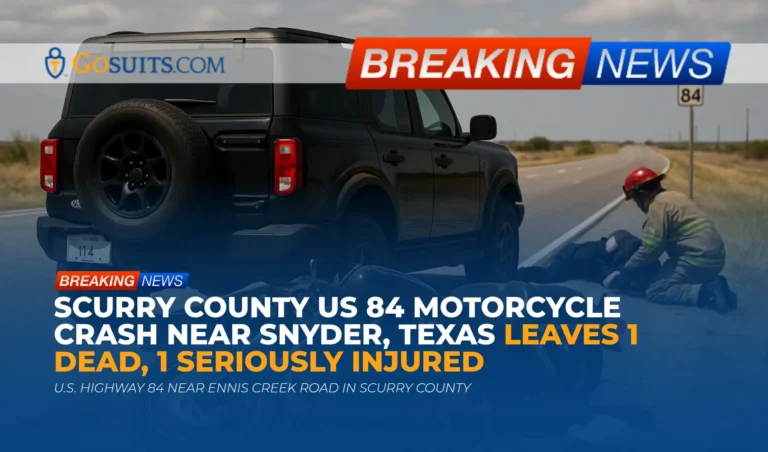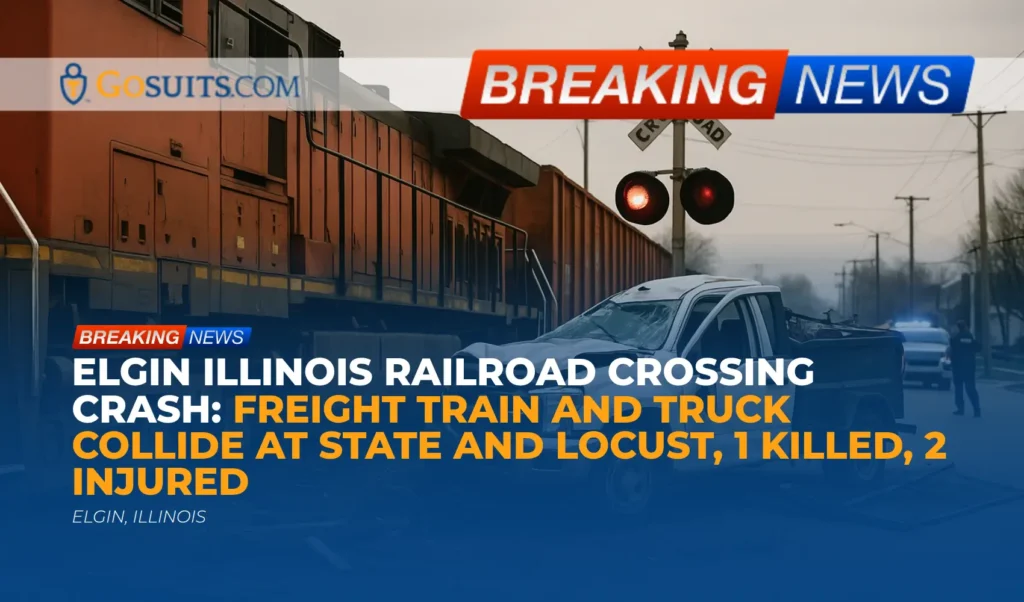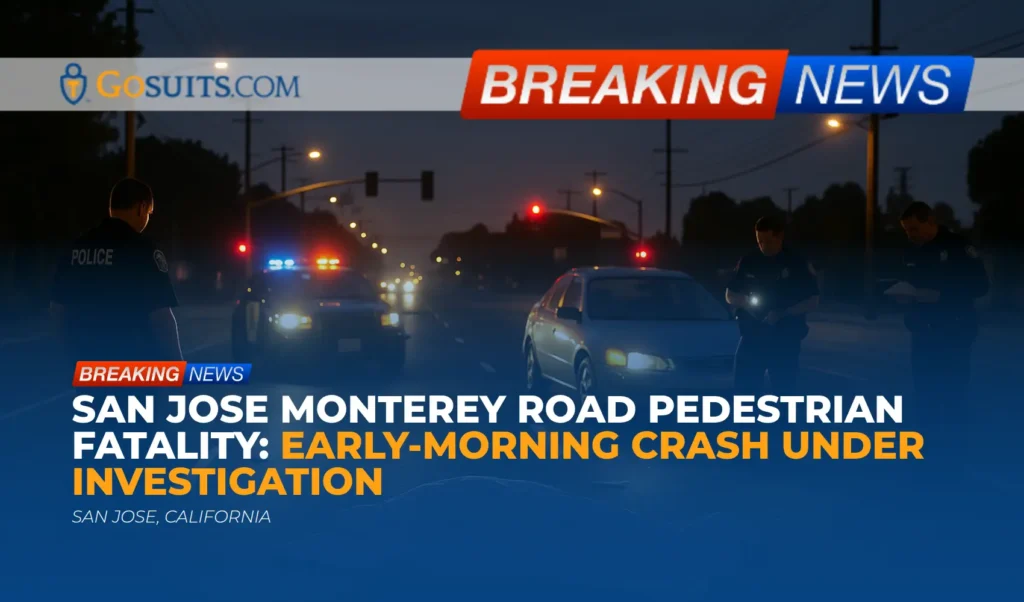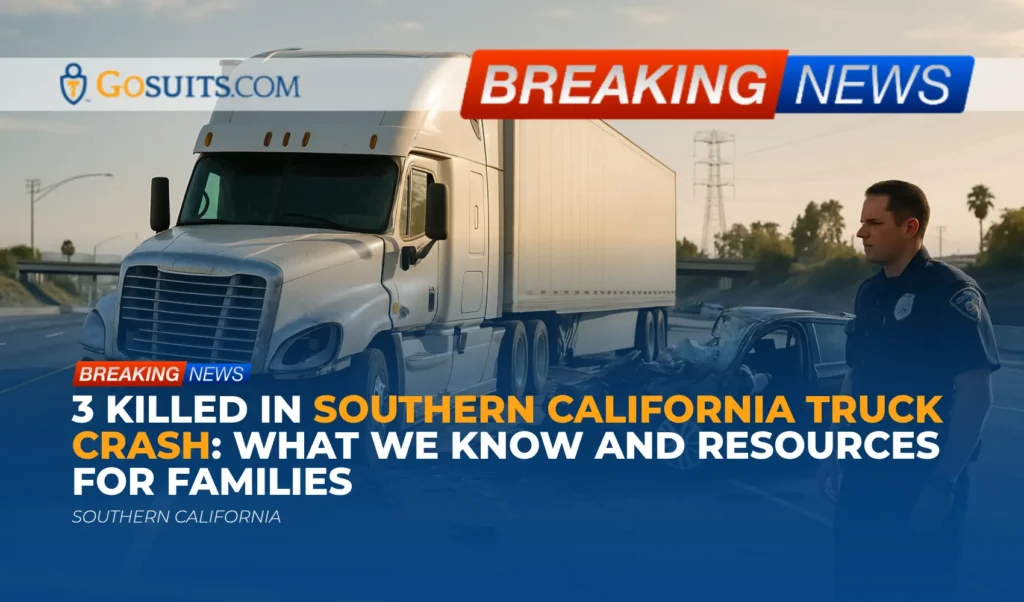- Scurry County Motorcycle Crash: What Happened
- Official Details Reported by Investigators
- Roadway Location and Conditions on U.S. 84
- Safety and Liability Considerations in a Rear-End Motorcycle Collision
- Potential Wrongful Death and Injury Claims Under Texas Law
- How Families Can Obtain Official Records and Documents
- Insurance Coverage Issues After a Serious Texas Motorcycle Crash
- Preserving Evidence and Requesting an Independent Investigation
- Caution When Dealing With Insurance Companies
- Important Time Limits in Texas Civil Cases
- Motorcycle Safety Context and Data
- Commentary from Gosuits Snyder, Texas Personal Injury Attorney
- Why Taking Action Matters Now
- Sources and References
Scurry County Motorcycle Crash: What Happened
A tragic collision on U.S. Highway 84 near Ennis Creek Road in Scurry County left one person deceased and another seriously injured. According to information reported by state authorities, the crash occurred early afternoon on October 16, 2025, near Snyder, Texas. A Harley-Davidson motorcycle traveling northbound struck the rear of a Ford Bronco that had just entered the highway. The motorcycle’s passenger, a 50-year-old woman from Hot Springs, Arkansas, was pronounced dead at the scene. The 55-year-old driver of the motorcycle, also from Hot Springs, sustained incapacitating injuries and was transported to a Lubbock hospital. The 67-year-old driver of the Bronco from Brownfield was not injured.
This loss is devastating. Our thoughts are with the family grieving a sudden death and with the injured rider who faces a serious recovery. The purpose of this article is to explain what is publicly known, outline practical steps for obtaining official records, and share general legal context that often applies in similar Texas highway crashes.
Official Details Reported by Investigators
Timeline and vehicles
State investigators reported that at approximately 12:30 p.m. on October 16, a 2022 Ford Bronco entered U.S. 84 from Ennis Creek Road and proceeded north in the left lane. A 2019 Harley-Davidson motorcycle traveling the same direction in the left lane collided with the rear of the Bronco.
Injuries and protective gear
The motorcycle’s passenger was pronounced deceased at the scene. The motorcycle driver suffered incapacitating injuries and was transported to University Medical Center in Lubbock. Authorities noted that both motorcycle occupants were wearing helmets, and the Bronco driver was wearing a seat belt.
Roadway conditions
Investigators indicated clear weather and dry road conditions. The posted speed limit on this portion of U.S. 84 is 75 mph.
Roadway Location and Conditions on U.S. 84
U.S. Highway 84 is a major corridor in West Texas carrying a mix of local, commuter, and commercial traffic, including large trucks. The location near Ennis Creek Road suggests a merge area where vehicles enter the mainline highway. Even under clear skies and dry pavement, merge areas can be hazardous, especially at high posted speeds, because the margin for error is small and closing speeds can develop quickly if one vehicle changes lanes or enters the roadway while others approach at highway speed.
Texas law emphasizes that drivers must select a speed that is reasonable and prudent for existing conditions, even when the posted limit is higher. In practice, that means both the merging driver and the through-traveling driver should be alert and prepared to adjust speed and position to avoid conflict.
Safety and Liability Considerations in a Rear-End Motorcycle Collision
Every collision is fact-specific, and responsibility depends on evidence. That said, there are recurring legal and safety considerations in a scenario where a vehicle enters a high-speed highway and a motorcycle behind collides with it.
Key Texas traffic rules that may be relevant
- Reasonable and prudent speed: Texas law requires drivers to operate at a prudent speed for conditions, not simply the posted limit. Sudden changes in traffic, merges, and lead vehicle movements can make a previously safe speed unsafe if following distance is insufficient. See Texas Transportation Code §545.351.
- Following distance and failure to control speed: Drivers must maintain an assured clear distance between themselves and the vehicle ahead so they can safely stop without colliding. See Texas Transportation Code §545.062.
- Entering a roadway: A driver entering a roadway must yield the right-of-way to vehicles already on the roadway if a hazard is presented. Depending on the entry context, provisions such as Texas Transportation Code §545.151 can be implicated.
On high-speed highways, both the entering vehicle and the following vehicle share responsibilities tied to these rules. The entering vehicle must not create an immediate hazard. The following vehicle must maintain a distance and speed that allow safe stopping. When a rear-end collision occurs, investigators often examine whether the lead vehicle’s entry or lane position created a sudden hazard and whether the following vehicle maintained adequate speed and distance.
Texas uses proportionate responsibility in civil cases, meaning fault can be allocated among multiple parties if the evidence supports it. See Texas Civil Practice and Remedies Code Chapter 33. Establishing how fault is apportioned typically requires thorough investigation, sometimes including scene measurements, vehicle data, and expert analysis.
Potential Wrongful Death and Injury Claims Under Texas Law
Wrongful death claims
When a death is caused by a wrongful act, neglect, carelessness, unskillfulness, or default, certain surviving family members may pursue a wrongful death claim under Texas law. The statute identifies which family members may bring a claim and outlines how damages may be sought. See Texas Civil Practice and Remedies Code Chapter 71.
Typically, the surviving spouse, children, and parents may bring a wrongful death claim. In addition, the decedent’s estate may bring a survival claim to recover certain damages the decedent could have claimed had they lived. The availability and scope of damages depend on specific facts and evidence.
Personal injury claims for the surviving rider
The injured motorcyclist may have a claim for bodily injury against any party whose negligence contributed to the collision. Recoverable categories can include medical expenses, lost income, and other legally recognized harms, depending on the evidence and applicable law.
Venue and choice of law considerations for out-of-state families
Because the crash occurred in Texas, Texas law and Texas courts commonly govern the civil claims, even when victims are from another state. Insurance arrangements and policy terms may add additional wrinkles if out-of-state policies are involved. These are fact-specific issues that benefit from case-by-case review.
How Families Can Obtain Official Records and Documents
After a fatal or serious-injury crash, official documents help families and representatives understand what happened and handle practical needs such as insurance, probate, and benefits. Below are the primary records and where to request them.
Texas crash report (CR-3)
In Texas, the official crash report is typically filed by the investigating officer or trooper and is maintained by the Texas Department of Transportation’s Crash Records Information System (CRIS). Eligible parties can purchase the CR-3 report online. See TxDOT’s CRIS purchase portal at https://cris.dot.state.tx.us/public/Purchase.
It can take several days to weeks for the report to be finalized, especially in serious cases where additional investigation is necessary. The CR-3 often includes the investigating agency’s narrative, diagram, and contributing factors as assessed by the officer.
Autopsy report and cause of death
In many Texas counties without a local medical examiner, the Justice of the Peace acts as coroner and may order an autopsy at a regional medical examiner facility. In this part of West Texas, autopsies are often conducted at regional offices such as the Lubbock County Medical Examiner. To inquire about an autopsy report, families can review the Lubbock County Medical Examiner’s information page: https://www.lubbockcounty.gov/departments/medical-examiner.
Before contacting a medical examiner’s office, it is helpful to have the decedent’s full name, date of birth, date of death, and the investigating agency’s case number. If unsure which office is handling the case, the Scurry County Sheriff’s Office or the Justice of the Peace can confirm the appropriate office and status.
Death certificate
Certified copies of a Texas death certificate are issued through the Texas Department of State Health Services Vital Statistics Section. Instructions and eligibility requirements are available here: https://www.dshs.texas.gov/vital-statistics. Families often need multiple certified copies for insurance, financial institutions, and estate administration.

EMS, hospital, and medical records
Emergency medical services run reports and hospital records can be requested by the patient or the patient’s authorized representative. Hospitals will usually require a HIPAA-compliant authorization. In severe-injury cases, coordinating medical records across multiple facilities can take time; requesting them early helps prevent delays in insurance coordination.
Property release and personal effects
The investigating agency can advise when the involved motorcycle and any personal effects may be released. If a vehicle is part of an ongoing investigation or needed for inspection, release may be delayed. Requesting the chain-of-custody status ensures important evidence is not lost or altered prematurely.
Insurance Coverage Issues After a Serious Texas Motorcycle Crash
Liability coverage
Texas requires motor vehicle liability insurance that can apply to bodily injury and property damage caused by a negligent driver. If an investigation finds that another driver’s negligence contributed to the crash, that driver’s liability carrier may be responsible up to policy limits.
Personal injury protection (PIP) and medical payments
PIP coverage is generally offered on Texas auto policies and applies unless it has been rejected in writing. PIP can help with medical bills and certain nonmedical costs regardless of fault. See the Texas Department of Insurance’s explanation of auto coverages at https://www.tdi.texas.gov/pubs/consumer/cb020.html. Some policies also include medical payments coverage with similar, though more limited, benefits.
Uninsured/underinsured motorist (UM/UIM)
UM/UIM can provide benefits when an at-fault driver lacks sufficient coverage. In complex crashes involving multiple vehicles or disputed liability, UM/UIM may be an important backstop. Texas insurers must offer UM/UIM and PIP; rejection must be in writing. See TDI’s guidance linked above.
Coordination of benefits and subrogation
Health insurance may pay medical bills upfront. Later, health plans and certain insurers may seek reimbursement from any recovery. Understanding these rights and obligations, including hospital liens and subrogation claims, can prevent unexpected issues at resolution.
Preserving Evidence and Requesting an Independent Investigation
Prompt preservation of evidence is critical in high-speed rear-end collisions, especially when visibility, lane position, and entry movements are disputed.
- Scene documentation: Timely photographs or video of the roadway, skid marks, debris fields, vehicle resting positions, and nearby surveillance or traffic cameras can be very helpful. Even after vehicles are cleared, tire scuffs and gouge marks may remain briefly.
- Vehicle inspections: The motorcycle and the Ford Bronco can contain crucial evidence. Independent inspections assess lighting, braking systems, damage profiles, and helmet and gear damage patterns. This often clarifies pre-impact speed, impact angles, and visibility.
- Event Data Recorder (EDR): Many passenger vehicles store pre-crash data including speed, brake application, throttle, and seatbelt status. Accessing and preserving EDR data should occur before the vehicle is repaired or salvaged. See NHTSA’s EDR information at https://www.nhtsa.gov/equipment/event-data-recorders.
- Witness statements: Independent witnesses can help resolve how the Bronco entered the highway, traffic flow, and whether sudden braking or lane changes occurred.
- Public records: The official CR-3 crash report, any supplemental diagrams, and, where applicable, drone or total-station measurements collected by the investigating agency provide foundational facts.
When substantial injuries or a death are involved, sending preservation letters to relevant parties, tow yards, and insurers can reduce the risk of evidence being lost.
Caution When Dealing With Insurance Companies
Insurance adjusters may contact people soon after a crash seeking statements and medical authorizations. It is important to recognize that statements can be used later to dispute liability or minimize the scope of harms and losses.
- Consider consulting a lawyer first: Before giving any recorded statement or broad medical authorization, it is prudent to speak with a personal injury attorney for a free consultation to understand rights and potential pitfalls. What is said to an insurance company can be used later in ways that are not obvious at the time.
- Limitations of quick settlements: Early offers sometimes arrive before the full extent of injuries or losses is known. Accepting a settlement typically requires a full release of claims, which may foreclose recovery if complications develop.
- Documentation matters: Keep all bills, records, and repair estimates organized. Accurate documentation often drives how insurers evaluate claims.
Important Time Limits in Texas Civil Cases
Texas generally applies a two-year limitations period to personal injury and wrongful death actions. See Texas Civil Practice and Remedies Code §16.003. There are exceptions and nuances, but missing a deadline can bar a claim, even if evidence of negligence is strong. Because timelines can vary based on the parties involved and specific facts, early attention to deadlines is important.
Motorcycle Safety Context and Data
Motorcycles are particularly vulnerable in high-speed environments due to shorter stopping distances relative to visibility requirements, exposure to wind buffeting, and limited conspicuity compared to larger vehicles. Even when riders wear appropriate protective gear, the forces in a 75 mph traffic environment are unforgiving.
- Speed and stopping: Higher speeds lengthen both the distance traveled during reaction time and the braking distance required to stop. NHTSA notes that speeding remains a major contributor to crash severity across roadway types. See NHTSA’s Speeding overview at https://www.nhtsa.gov/risky-driving/speeding.
- Motorcycle risk: NHTSA’s Motorcycle Traffic Safety Facts consistently show that motorcyclists face a disproportionately high risk of fatal and serious injury crashes compared to occupants of passenger vehicles. See NHTSA’s motorcycle safety resources at https://www.nhtsa.gov/road-safety/motorcycles.
- Reasonable and prudent speed duty: Texas law underscores that drivers must moderate speed for conditions, even with clear weather and dry pavement. See Texas Transportation Code §545.351.
- Following distance: Maintaining an assured clear distance remains a core rule for avoiding rear-end collisions. See Texas Transportation Code §545.062.
These principles are not about assigning blame in the absence of a full investigation. Rather, they reflect safety dynamics that often appear in high-speed, same-direction collisions involving motorcycles and merging vehicles.
Commentary from Gosuits Snyder, Texas Personal Injury Attorney
First and foremost, our hearts go out to the family of the woman who lost her life and to the rider who was seriously injured. A sudden loss on a clear day under ordinary driving conditions is deeply painful and disorienting. This commentary is offered for educational purposes and general information to help the community understand the issues that typically arise after a serious highway crash.
Based on what officials have shared, this was a same-direction, rear-end collision following the Bronco’s entry onto U.S. 84. In our experience with high-speed collisions, key questions usually include when the Bronco merged into the left lane, whether its movement created an immediate hazard, the motorcycle’s speed and following distance, and what traffic conditions existed in the moments before impact. Objective data often tells the story: EDR readings from the Bronco, roadway measurements, and witness accounts can clarify timing and closing speeds in a way that goes beyond initial impressions.
Insurance companies and corporations know how to move quickly after an incident like this. They may seek recorded statements before anyone has the crash report, medical records, or vehicle data. They sometimes frame questions in ways that shift responsibility or minimize losses. When people are grieving or hospitalized, it is hard to anticipate how a phrase in a recorded call might later be used. That is why it is sensible to get a free consultation before speaking at length with any insurer. Understanding rights and the evidence needed early on can prevent avoidable missteps.
A free consultation does not obligate anyone to take further steps. It is simply an opportunity to discuss the process, potential insurance coverages, timelines, and ways to preserve evidence while everyone is still gathering the facts. Families deserve clarity, compassion, and time to make informed decisions.
Why Taking Action Matters Now

What to do next
- Request official records: Obtain the Texas CR-3 crash report from TxDOT when available. Ask the investigating agency for the case number, and confirm where any autopsy is being handled. Order certified death certificates through the state vital records office.
- Preserve evidence: Ensure the motorcycle and any involved vehicle are preserved for inspection. Ask tow yards and insurers in writing not to dispose of or repair vehicles until inspections and data downloads are completed.
- Organize documentation: Keep medical bills, transport records, photographs, and correspondence together. Start a timeline of events and symptoms; contemporaneous notes can be helpful later.
- Consult before calling insurers: Consider speaking with a personal injury attorney for a free consultation before providing recorded statements or signing medical authorizations for any insurance company.
Why now
- Evidence fades: Skid marks dissipate, memory fades, and vehicles can be repaired or salvaged. Early preservation can make a decisive difference in understanding how the crash happened.
- Deadlines apply: Texas imposes statutory deadlines for civil claims. Identifying the correct parties and coverages in time requires lead time.
- Insurance positioning: Insurers often start building their position immediately. Balanced information and careful communication help protect rights.
Where it matters
- At the scene and storage facilities: Vehicle condition, EDR data, and physical evidence need timely attention.
- With state agencies: TxDOT for the crash report; medical examiner or JP for cause-of-death records; DSHS Vital Statistics for certificates.
- In claim files: Early, accurate documentation shapes how insurers evaluate responsibility and damages.
Sources and References
- Texas Department of Transportation (TxDOT) Crash Reports, CRIS Purchase Portal
- Texas Transportation Code §545.351, Maximum Speed Requirement
- Texas Transportation Code §545.062, Following Distance
- Texas Transportation Code §545.151, Vehicle Entering the Highway
- Texas Civil Practice and Remedies Code Chapter 33, Proportionate Responsibility
- Texas Civil Practice and Remedies Code Chapter 71, Wrongful Death
- Texas Civil Practice and Remedies Code §16.003, Limitations for Personal Injury and Wrongful Death
- Texas Department of Insurance, Auto Insurance Coverages
- Lubbock County Medical Examiner, Information and Contacts
- Texas Department of State Health Services, Vital Statistics
- NHTSA, Event Data Recorders
- NHTSA, Motorcycle Road Safety
- NHTSA, Speeding and Crash Risk






